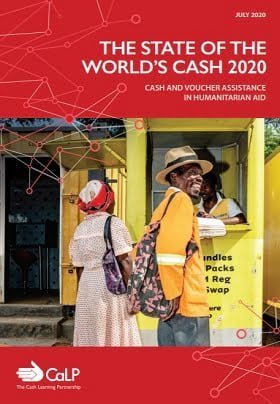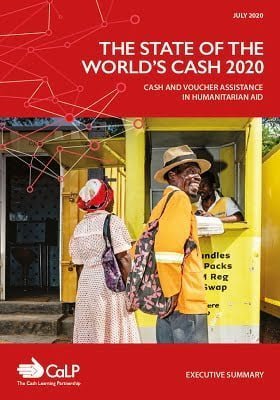State of the World’s Cash 2020 Chapter 1: Funding, policies, volume, and collaboration
VOLUME AND FUNDING
The global volume of CVA reached US $5.6 billion in 2019, having increased year-on-year from $2 billion in 2015. CVA also grew as a percentage of international humanitarian assistance, standing at 17.9% in 2019, up from 7.9% in 2015.

Growth in the use of CVA is expected to continue. Among other things, the relative efficiency of CVA is likely to promote scale-up, particularly as the gap between needs and funding widens and the pressure to ‘do more with less’ increases.

![]() Growth in the use of CVA remains uneven across humanitarian actors. The proportion of CVA funding programmed by the UN and its partners has increased annually since 2017, reaching 63% in 2019.
Growth in the use of CVA remains uneven across humanitarian actors. The proportion of CVA funding programmed by the UN and its partners has increased annually since 2017, reaching 63% in 2019.
![]() The use of cash transfers, relative to vouchers, has increased as a percentage of CVA since 2015, constituting three quarters of the total in 2019.
The use of cash transfers, relative to vouchers, has increased as a percentage of CVA since 2015, constituting three quarters of the total in 2019.
![]() The tracking of CVA volumes has improved, with reporting requirements agreed. However, significant work and investment is still required to achieve commitments in this area.
The tracking of CVA volumes has improved, with reporting requirements agreed. However, significant work and investment is still required to achieve commitments in this area.
DONORS AND POLICIES
![]() Since 2017, agencies and donors have made more progress towards meeting policy commitments towards increasing the use and quality of CVA.
Since 2017, agencies and donors have made more progress towards meeting policy commitments towards increasing the use and quality of CVA.
![]() Overall, donors’ CVA positioning is perceived to be stronger, clearer, and better coordinated than before. However, more consistency on sector issues and at country level would benefit the planning of interventions.
Overall, donors’ CVA positioning is perceived to be stronger, clearer, and better coordinated than before. However, more consistency on sector issues and at country level would benefit the planning of interventions.
![]() There has been more focus on supporting collaborative approaches to CVA.
There has been more focus on supporting collaborative approaches to CVA.
PRIORITY ACTIONS
- All humanitarian actors should push for improvements in the quality of CVA across the humanitarian system, putting ambitions for more and better CVA into practice, building on initiatives such as the Common Donor Approach.
- Donors should provide more flexible, multi-year funding, enabling better integrated programming to address basic needs, including supporting sector-specific activities where needed. Operational agencies should be more propositional and transparent about what effective programming looks like and costs.
- All humanitarian actors should build towards more cross-coordination and partnership between collaborative delivery initiatives, and include a broader range of stakeholders, including national and local actors.
- All humanitarian actors should commit to and work towards the minimum requirements for tracking CVA. Donors should support the strengthening of systems for programme and financial management and reporting.
Project leads
Further reading

The State of the World’s Cash 2020 – Full report
Report
Since the first State of the World’s Cash report we have seen huge developments in cash and voucher assistance (CVA), with a continued increase in scale driving changing roles and partnerships, and a growing emphasis on quality. This new report, State of the World’s Cash 2020, examines progress, changes, and challenges in the use of CVA within the rapidly shifting humanitarian landscape...

The State of the World’s Cash 2020 – Executive summary
Report
The State of the World’s Cash 2020 provides a comprehensive snapshot of cash and voucher assistance (CVA), with significant recommendations for anyone interested in humanitarian action. This report follows on from the first report, a seminal piece, published in 2018. Since then CVA has continued to grow and is now a major part of almost every humanitarian response. The total amount of CVA...



